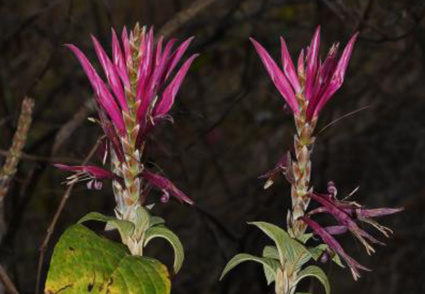Abstract
Aphelandra almanegra, a new species from tropical dry forest in Antioquia department, Colombia, is described, illustrated and mapped. Notes are given on its geographical distribution, phenology, conservation status and taxonomic affinities. It is compared with its morphologically closest relative Aphelandra pulcherrima, which differs by its habit, indumentum and various inflorescence characters. This species is restricted to dry forests of the Cauca River canyon, in the northwest of Colombia, a highly degraded and threatened ecosystem.
References
- Alvarez, M. (1997) Caracterización ecológica de cuatro remanentes de Bosque seco tropical de la región de Caribe Colombia. Instituto de Investigación de Recursos Biológicos Alexander von Humboldt-Grupo de Exploración y Monitoreo Ambiental Gema, Villa de Leyva, 58 pp. [http://hdl.handle.net/20.500.11761/9318]
- Brown, R. (1810) Prodromus florae Novae Hollandiae et Insulae Van-Diemen, exhibens characteres plantarum. R. Taylor et Socii, London, 145–590 pp. https://doi.org/10.5962/bhl.title.52309
- Corzo, G. & Delgado, J. (2012) Escenarios Geográficos para la Restauración del Bosque Seco en Colombia, Informe Final de Consultoría. Universidad ICESI—Instituto de Investigación de Recursos Biológicos Alexander von Humboldt—Ministerio de Ambiente y Desarrollo Sostenible.
- Daniel, T.F. & McPherson, G. (2014) A new species of Aphelandra (Acanthaceae: Acantheae) from Panama with notes on some Colombian species. Brittonia 66: 321–328. https://doi.org/10.1007/s12228-014-9338-0
- Dauby, G. (2019) ConR: Computation of Parameters Used in Preliminary Assessment Conservation Status. Available from: https://cran.r-project.org/src/contrib/Archive/ConR/ (accessed: 14 May 2024)
- Díaz Pulido, G. (1997) Informe nacional sobre el estado de la biodiversidad en Colombia. Programa de biodiversidad y ecosistemas marinos. Instituto de investigaciones marinas y costeras INVEMAR, Santa Marta, 143 pp.
- DRYFLOR (2016) Plant diversity patterns in neotropical dry forests and their conservation implications. Science 353: 1383–1387. https://doi.org/10.1126/science.aaf5080
- Ellis, B., Daly, D.C., Hickey, L.J., Johnson, K.R., Mitchell, J.D., Wilf, P. & Wing, S.L. (2009) Manual of leaf architecture. Cornell University Press, Ithaca, New York, 190 pp. https://doi.org/10.1079/9781845935849.0000
- García, H., Corzo, G., Isaacs-Cubides, P.J. & Etter, A. (2014) Distribución y estado actual de los remanentes del bioma de Bosque Seco Tropical en Colombia: insumos para su gestión. In: Pizano, C. & García, H. (Eds.) El bosque seco tropical en Colombia. Instituto de Investigación de Recursos Biológicos Alexander Von Humboldt. Bogotá, pp. 229–251.
- Harris, J.G. & Harris, M.W. (1994) Plant identification terminology: an illustrated glossary. Spring Lake Publishing, Utah, 216 pp.
- Hewson, H.J. (2019) Plant indumentum: a handbook of terminology, revised edition. Australian Biological Resources Study, Commonwealth Department of the Environment and Energy, Canberra, 47 pp.
- IUCN (2012) IUCN Red List Categories and Criteria: Version 3.1. Second edition. IUCN Species Survival Commission. IUCN, Gland, Switzerland and Cambridge, England, 32 pp.
- Jacquin, N.J. von (1760) Enumeratio systematica plantarumquas in insulis Caribaeis vicinaque Americes continente detexit nouas, aut iam cognitas emandauit. Apud Theodorum Haak, Lugduni Batavorum [Leiden], 41 pp. https://doi.org/10.5962/bhl.title.737
- Jansen, D.H. (1988) Management of habitat fragments in a tropical dry forest. Annals of Missouri Botanical Garden. 75: 105–116. https://doi.org/10.2307/2399468
- Humboldt, F.W.H.A., Bonpland, A.J.A. & Kunth, K.S. (1817) Nova Genera et Species Plantarum (t.2 [Quarto]). Librariae Graeco-Latino-Germanico, Lutetia Parisiorum [Paris], 405 pp. https://doi.org/10.5962/bhl.title.640
- Leonard, E.C. (1953) The Acanthaceae of Colombia, II: subfamily Acanthoideae. Contributions from the United States National Herbarium, 31 (2): 119–322.
- Leonard, E.C. (1954) Acanthaceae. In: Baker, R.E.D., Cheesman, E.E., Leonard, E.C., Morton, C.V., Sandwith, N.Y. & Taylor, P. (Eds.) Flora of Trinidad and Tobago 2 (5). Government Printing Office, Port of Spain, pp. 357–379.
- Llamozas, S. (2016) Sinopsis del género Aphelandra R. Br. (Acanthaceae) en Venezuela. Acta Botanica Venezuelica. 16: 29–53. [https://www.jstor.org/stable/41740498]
- Manzitto-Tripp, E.A., Darbyshire, I., Daniel, T.F., Kiel, C.A. & McDade, L.A. (2022) Revised classification of Acanthaceae and worldwide and dichotomous keys. Taxon 71: 103–153. https://doi.org/10.1002/tax.12600
- McDade, L.A. (1984) Systematics and reproductive biology of the Central American species of the Aphelandra pulcherrima complex (Acanthaceae). Annals of the Missouri Botanical Garden 71: 104–65. https://doi.org/10.2307/2399058
- McDade, L.A. (1988) Recognition of Aphelandra glabrata (Acanthaceae) from Western South America, with notes on phylogenetic relationships. Systematic Botany 13: 235–39. https://doi.org/10.2307/2419102
- McDade, L.A., Daniel, T.F., Kiel, C.A. & Vollesen, K. (2005) Phylogenetic relationships among Acantheae (Acanthaceae): major lineages present contrasting patterns of molecular evolution and morphological differentiation. Systematic Botany 30 (4): 834–862. https://doi.org/10.1600/036364405775097734
- Miles, L., Newton, A., Defries, R., Ravilious, C., May, I., Blyth, S., Kapos, V. & Gordon, J. (2006) A global overview of the conservation status of tropical dry forests. Journal of Biogeography 33: 491–505. https://doi.org/10.1111/j.1365-2699.2005.01424.x
- Nees von Esenbeck, C. (1847) Acanthaceae. In: de Candolle, A.C. (Ed.) Prodromus Systematic Naturalis Regni Vegetabilis. Treuttel & Würtz, Paris, pp. 46–519.
- Thiers, B. (2024 [continuously updated]) Index herbariorum: a global directory of public herbaria and associated staff. New York Botanical Garden’s Virtual Herbarium. The New York Botanical Garden, Bronx, New York. Available from: http://sweetgum.nybg.org/science/ih/ (accessed 6 June 2024)
- Vahl, M. (1794) Symbolae Botanicae Sive Plantarum Tam Earum Quas in Itinere Imprimis Orientali. Imprensis Auctoris Excudebant N. Möller et filius, Hauniae, 475 pp.
- Wasshausen, D.C. (1975) The genus Aphelandra (Acanthaceae). Smithsonian Contributions to Botany 18: 1–157. https://doi.org/10.5479/si.0081024X.18


